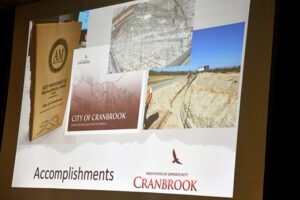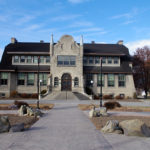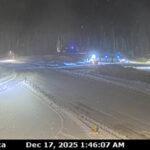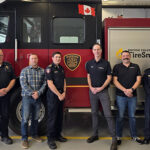Home »

Mayor Price provides city update to chamber and Rotary
For the first time since before the start of the COVID-19 pandemic in 2020, the Cranbrook Chamber of Commerce, in concert with the Cranbrook Rotary Club, provided a forum for a mayoral update on the state of the City of Cranbrook.
Mayor Wayne Price addressed a packed conference room at the Heritage Inn today (March 28), outlining changes that have occurred in the past four years, as well as accomplishments, challenges, rising costs and taxes, aging infrastructure and solutions and approaches to all going on in the city during a detailed 45-minute address and Q&A session.
“At the start of the municipal election campaigns in 2022 most candidate’s platforms started with what were once the common priorities – infrastructure, growth and development, controlling taxes, etc.
“By the time campaigning was over voter priorities had changed. Community and social issues such as homelessness, inadequate housing, crime and the opioid crisis had become community priorities,” Mayor Price opened. The following is taken from a copy of his speech, which he often expanded upon during his presentation.
“This was a new focus for local officials, as social issues of this nature, had traditionally been the responsibility of senior governments. There became an expectation that local governments would be part of a solution when they had no legislative authority or financial means to deal with the issues. This and the ability to provide current service levels at current costs have become some of the new challenges for local government.
“The current council is confident, that with the leadership of CAO (Mark) Fercho and the team he has built, we can manage ongoing change as we move forward. Obviously, some decisions that will needed to be made may not be popular, but that goes with the job – that’s in part what we are elected for.
“This council’s approach to our four-year term was to first ensure required policy and framework are in place to support the activities and undertakings identified in our strategic and five-year financial plans. Year two and onward are to be years of action.
“Despite year one being a planning year, a number of notable accomplishments were completed in 2023.
- The Cranbrook Tourism Master Plan was completed.
- The Downtown Revitalization Master Plan was completed.
- We Completed a Water System Asset Management Plan.
- We Completed a new Strategic Plan with Council and Administration.
- A Social Development Coordinator position was created.
- . The Shadow Mountain Sanitary Sewer connection was completed. Buildout of this development has been limited due to the lack of an adequate sewer system. We are expecting to see a number of projects starting this year that will hopefully kickstart development in a similar way that New Dawn influenced Wildstone.
- We saw a number of capital upgrades at the airport including airfield lighting replacement, Water/sewer assessment and HVAC replacement.
- The city undertook emergency repairs to the Memorial Arena Structural beams which will extend building life another 15 – 20 years.
- The City of Cranbrook was awarded the B.C. Community Asset Management Award for BC Municipalities.
- The City received a $5.5M Growing Communities Fund Grant – which will offset city costs for required upgrades to the wastewater lagoons and influent trunk main.
- The city was recently awarded $9.5M grant from the Investing in Canada Program for a Phillips Reservoir Disinfection Facility. (City $3.46M)
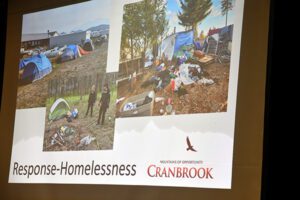 “Let’s have a look at some of our challenges.
“Let’s have a look at some of our challenges.
“Many of the challenges that the City of Cranbrook is facing are similar to those of municipalities across Canada. Some of ours include: homelessness; inadequate housing; increasing crime; wildfire; increasing taxes resulting from aging infrastructure, costs of goods and services, limited tax base and recognition of true costs
SOLUTIONS/ACTION RESPONSE
“Homelessness has become an international issue that is likely to be a generational problem. To date, there has not been a magic bullet that has been able to provide a solution. Most issues associated with homeless are senior government level responsibilities.
“Recognizing that one of the purposes of a municipality is to foster the social well-being of its community, we have some form of mandated, as well moral responsibility, to deal with homelessness.
“Our findings are that most of our homeless are from Cranbrook and surrounding areas of the East Kootenay. That in a sense comes with being a regional centre, where we provide health care and related services that are not available in the smaller communities. Essentially, this is more of a regional issue than just a Cranbrook issue.
“In recognition of this the RDEK (Regional District of East Kootenay) has stepped up and provided $85,000 towards the Social Development Coordinator position. The Social Development Coordinator is tasked with working with local service providers, support agencies and the RCMP to identify overlaps and gaps in services and ensure a coordinated approach is taken in dealing with the homelessness, mental health and addiction issues.
“At the beginning 0f 2024, council approved the formation of a Mayor’s Task Force on Homelessness and Community Safety & Wellbeing. The committee is comprised of key stakeholders, who have an understanding and experience with issues related to homelessness and community wellbeing. The committee is tasked with finding solutions for the challenges that are impacting business and the overall community.
“We are hopeful that some of the recommended solutions will be acted upon as the Task Force moves forward. When the role of the task force is completed a final report will be produced, which will provide recommendations at the local level, as well as to province.
“The city formed a Situation Table that acts as a triage table, representing all sectors of service providers, to identify and support people in the community identified as elevated risk. The group of 20 agencies and support people meet weekly and activate support within 48 hours.
“Currently, the day-to-day issues with the homeless are being managed by agencies, local nonprofits, the RCMP and city staff. Going forward we will continue to work with local agencies and the province to lessen the impact of homelessness on businesses and the community.
 “Inadequate Housing is a problem across Canada. At the start of 2024, council approved the formation of a Mayor’s Task Force on Housing. The intention is to help drive the creation of a comprehensive Housing Strategy that will form a blueprint in addressing the city’s housing needs. The solutions will be based on our updated Housing Needs Assessment Report.
“Inadequate Housing is a problem across Canada. At the start of 2024, council approved the formation of a Mayor’s Task Force on Housing. The intention is to help drive the creation of a comprehensive Housing Strategy that will form a blueprint in addressing the city’s housing needs. The solutions will be based on our updated Housing Needs Assessment Report.
“In 2023, the city undertook a city-owned land inventory to in part identify city-owned lands that may be considered for affordable housing development.
“The Task Force is comprised of housing industry developers, nonprofits, and housing strategy experts. Part of the purpose for bringing the members of the Task Force together is to form potential business and partner alliances and form collaborations for housing projects.
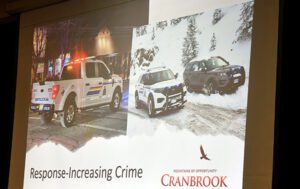 “Increasing Crime is a concern in most B.C. municipalities. The city has been working very closely with the RCMP over the last few years to develop a City of Cranbrook Community Policing Model.
“Increasing Crime is a concern in most B.C. municipalities. The city has been working very closely with the RCMP over the last few years to develop a City of Cranbrook Community Policing Model.
“The city has supported the addition of four new watch clerks who can undertake most of the administrative work that has been required by on-shift members. The addition of a watch clerk on each shift could add up to as much as 70% more operational efficiency to each shift.
“Council has approved an additional two RCMP members over the last two years in an attempt to ensure adequate staffing levels. We were recently informed that our detachment currently has a full complement of staffing for the first time in more than a decade. We have also approved a Records Management Supervisors position which should add efficiencies to their operations.
“For the first time in a number of years, council met with the RCMP Detachment Commander to discuss our local community policing concerns and needs.
“Council is optimistic that these new supports will have an effect in reducing crime.
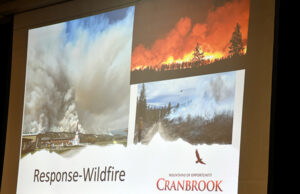 “Wildfire is perhaps Cranbrook’s highest natural disaster risk. A number of years ago the city merged with the RDEK to form a regional Emergency Management Program. Our joint Regional Emergency Program with the RDEK is a model that is recognized throughout the province. More recently we have combined our Fire Mitigation Programs, which further adds resiliency and efficiency to our wildfire program.
“Wildfire is perhaps Cranbrook’s highest natural disaster risk. A number of years ago the city merged with the RDEK to form a regional Emergency Management Program. Our joint Regional Emergency Program with the RDEK is a model that is recognized throughout the province. More recently we have combined our Fire Mitigation Programs, which further adds resiliency and efficiency to our wildfire program.
“We are very fortunate to have a relationship with the RDEK and area communities which provides a very high-level emergency organization. I have been involved with a number of EOCs (Emergency Operation Centres) over the years and I can honestly say that the RDEK regional program is among the best.
“Increasing Taxes is becoming a significant issue for local governments across Canada. The cost to provide services has outpaced the financial ability to provide those same level of services. Local service fees and property taxes can no longer support current service expectations.
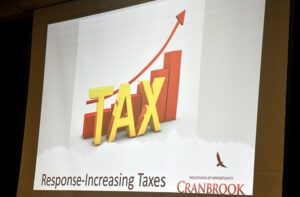 “The current municipal government funding model needs to be changed in order for municipalities to control tax rates. Consider that local government only collects about 12 cents of every dollar paid in Canada. Municipalities across Canada have begun to organize in attempt to work with senior government to find solutions to acquire alternate revenue sources.
“The current municipal government funding model needs to be changed in order for municipalities to control tax rates. Consider that local government only collects about 12 cents of every dollar paid in Canada. Municipalities across Canada have begun to organize in attempt to work with senior government to find solutions to acquire alternate revenue sources.
“On a local scale, the City of Cranbrook faces some revenue/service provision challenges, as a result of being a regional centre. Certainly, some housing and homelessness issues come with being a regional centre. As well, the Cranbrook taxpayer also subsidizes residents in the regional area for some services.
“Currently, Area C residents in the RDEK do not contribute to the city for use of our recreation and culture facilities. It is estimated that approximately 20% of the users are from Electoral Area C. Annual operational cost for these facilities is approximately $5M per year and debt servicing is around $1M per year. Doing the math, 20% of $6M would be about $1.2M. Considering one per cent of our tax levy is approximately $357,000 this year, a 20% contribution would have a significant positive impact on our annual budget.
“Approximately 3.5% and that’s not including any capital costs. CAO Fercho and I recently met with the RDEK to discuss this concern and we are confident we can find a mutual solution to this issue for the next budget year.
“I should add that the RDEK contributes 20% of the Cranbrook Public Library cost to the city and pays approximately 20% of the fire department budget to the city for rural fire protection services.
“As well, the City of Cranbrook pays the RCMP for municipal policing. Consider that last year, 19% of Cranbrook detachment response to calls were in the RDEK. We will be examining our policing contract to see if we can obtain some form of cost recovery from the province. RCMP Operational approximately $6M.
“In years past most municipal councils were committed to keeping tax rates low and in line with other communities. Two practices that were common to keep the rate down was to draw down reserves and to defer large cost capital projects until they could be supported by senior level government grants. Many current councils are now faced with inadequate reserves, and /or are faced with paying through borrowing, the full cost of deferred projects that have become critical.
“We have witnessed where a multi-year deferred capital works project that was initially estimated to cost $4M has resulted in over double the cost years later.
“This year council will be working with administration and finance to modify our budgeting model to improve budgeting efficiencies.
“We are currently in the process of conducting a service review of our rec and culture program to determine if the current business model is suited for today’s needs. I expect some recommendations from this review may be applied to some of our other services.
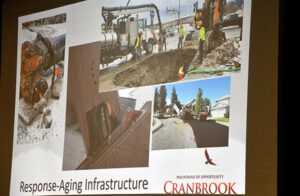 “True Costs of some projects and services have been overlooked that can have an unforeseen impact on city budgets. A couple of examples would be our sewage lagoons and cemetery.
“True Costs of some projects and services have been overlooked that can have an unforeseen impact on city budgets. A couple of examples would be our sewage lagoons and cemetery.
“For a number of years, the city was funding a lagoon desludging reserve in the amount of $145,000 per year. The desludging occurred infrequently and not according to a set maintenance schedule. Over time we got behind in the desludging maintenance and in order to maintain a reliable schedule are paying an additional $1.1M into the reserve over the next 2 years.
“As well, a recent review of our cemetery Management Plan suggests we have been undercharging fees and maintenance and running at a deficit.
“The Cranbrook taxpayer subsidizes the Transit system approximately $1M per year, almost three per cent of our current tax levy.
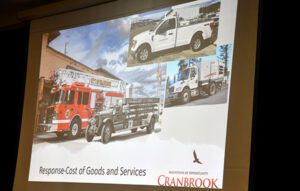 “Aging infrastructure is a major concern for all municipalities across Canada. It is impossible to maintain existing failing infrastructure and/or provide new infrastructure required for development without senior level government funding and private sector development support.
“Aging infrastructure is a major concern for all municipalities across Canada. It is impossible to maintain existing failing infrastructure and/or provide new infrastructure required for development without senior level government funding and private sector development support.
“City staff take advantage of every funding opportunity that we know is available, however, for the last number of years we have not been as successful as we were in the past. A lot of these types of grants are considered competitive grants and it may be a matter of not meeting specific criteria for our projects. Staff continue to submit quality applications as future funding opportunities arise.
“In 2023 we received a $5.5M Growing Communities Fund Grant that was utilized for a critical sewage lagoons upgrade project.
“Last week we were awarded $9.5M grant from the Investing in Canada Program for a Phillips Reservoir Disinfection Facility. This is a project that would have become a near future mandatory requirement, so we are very grateful for the Federal and Provincial government support.
“This year CAO Fercho and I are planning a number of meetings with provincial ministers to lobby for support for potential development opportunities and advocate for additional infrastructure funding.
“Council will continue to fund the1% annual road program which equates to $3,409,425 this year. This tax was introduced by Mayor Ross Priest’s council and CAO Will Pierce in the mid 2000s and at that time was worth somewhere around $170,000 or $180,000 per year. This is a very good example of the benefits of forward-thinking council decisions. It is certainly a legacy program that serves Cranbrook’s geological related road conditions well.
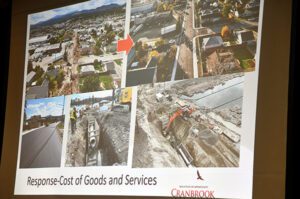 “Costs of goods and services have skyrocketed since Covid. Every family can see the inflated costs of their basket of goods. The inflationary rate of those goods is based on the CPI and a basket of domestic level goods. Local governments basket of goods increases are not based on the CPI.
“Costs of goods and services have skyrocketed since Covid. Every family can see the inflated costs of their basket of goods. The inflationary rate of those goods is based on the CPI and a basket of domestic level goods. Local governments basket of goods increases are not based on the CPI.
“The price of our basket of goods and services are impacted on an industrial level. Consider the following.
- In 2019 a Public Works pick-up truck cost $32,500 + taxes. Today the same truck costs $49,000 + taxes.
- In 2019 a Sweeper cost $325,000 + taxes. Today it costs $490,000 +taxes.
- Seven years ago a Fire Engine cost was $740,000. Essentially the same RFP in 2023 came back t $1.4M. That’s 89% increase in that market.
“Further Consider:
- 300 meters of mill and fill paving at 11.0 meters wide cost $250,000 in 2017/2018; 2024 cost is $450,000.
- In 2017/2018 one block of roads, curb and gutter, sidewalks, watermain and services cost between $675,000 and $750,000; and 2024 estimates for the same work is $1.3M.
“Consider that approximately $358,000 represents 1% of our tax levy – you can see that current service levels and/or funding models are not sustainable.
“Starting next year council will be approving all large dollar capital expenditures near the start of the budget process to be first out for tenders, and hopefully getting best prices. We want to try to beat the budget rush.
“We are now at a point where we have to consider critical expenditure budgeting going forward, as it is becoming apparent that costs to provide services have outpaced the cost of municipalities to adequately fund them through property taxation.
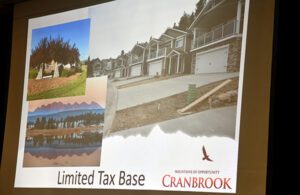 “Cranbrook has been impacted by a limited tax base for a number of years. We lack any industrial tax base and rely on residential and commercial taxation revenues. That can make tax rate comparisons with other communities difficult. Take for example regionally: Fernie, Elkford and Sparwood receive Industrial Tax Base Sharing Revenue that offsets between 26% and 54% of their tax burden. The City of Trail receives Industrial Tax Sharing revenues that offsets approximately 54% of their tax burden.
“Cranbrook has been impacted by a limited tax base for a number of years. We lack any industrial tax base and rely on residential and commercial taxation revenues. That can make tax rate comparisons with other communities difficult. Take for example regionally: Fernie, Elkford and Sparwood receive Industrial Tax Base Sharing Revenue that offsets between 26% and 54% of their tax burden. The City of Trail receives Industrial Tax Sharing revenues that offsets approximately 54% of their tax burden.
“Fort St. John, which is often referenced as a comparable community in size, receives a $36M funding contribution through the Peace River Agreement.
“I think it important that when using comparisons, people are using apples for apples.
“Cranbrook has been dependent upon new commercial and residential development to offset increasing tax rates. New housing is part of the solution. With the current housing shortage it is difficult to attract new professional and workers to expand our business base. High density development has been identified as one means of addressing our shortage. I know that some people are opposed to high density development but consider that each door brings approximately $1,400 in annual taxes.
“Acquiring new revenue sources, though building and economic development must be a priority for council. Developing new industrial lands is essential and staff have been working with senior government to make development of a new industrial area a priority.
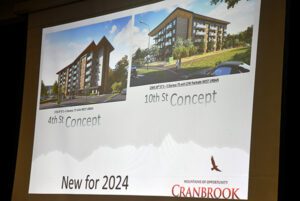 “Some of the new projects we hope to see in 2024 include:
“Some of the new projects we hope to see in 2024 include:
- Two new high rise apartments 4th Street North and 10th Street North (five storey and six storey).
- Anticipating accelerated growth in development at Shadow Mountain.
- At this time we have approximately 24 active subdivision applications before our Approval Officer which could create an additional xx new doors.
- Will see Completion of Housing Task Force Report.
- Completion of Task Force on Homelessness & Community Safety & Wellbeing Report.
- Will see Development of a Business Continuity Plan.
- In June Introduction of Mechanized Curbside Garbage Pickup.
- This year PSD City Wide Software online for Building Permits this year. Contractors will have the ability to Apply, submit and track applications digitally. Other types of applications next year. Speed up the development process.
- Develop a borrowing and debt serving policy.
“Obviously, these initiatives will not provide solutions for all of our problems – but it is a start – a strategic start. We understand that much more needs to be done – and will be done. I can assure you that we are committed to being a council and administration of action and accountability.
“I am very optimistic about the future of Cranbrook. We have a setting and sense of community that can only be envied by people in other areas of the world or this country. We are fortunate to have diverse, caring and committed council and staff, that I believe, truly care for the best interests of our city.
“One thing that I think is common with successful organizations is that they have strong CEOs and strong leadership.
“We are fortunate to have excellent leadership in our CAO, Mark Fercho and our department leaders and staff who are capable of taking this city to the next level.
“Thank you.”
Lead image: Mayor Wayne Price addresses chamber and Rotary members today (March 28) at the Heritage Inn. Ian Cobb/e-KNOW photos
e-KNOW
